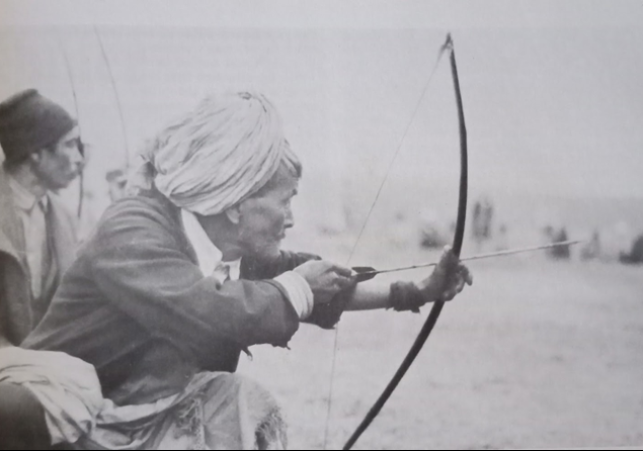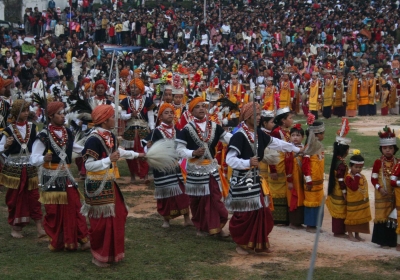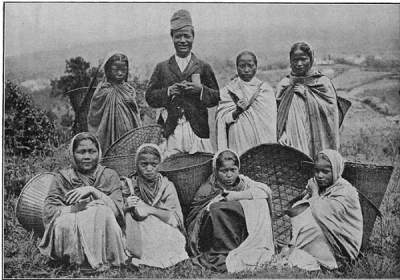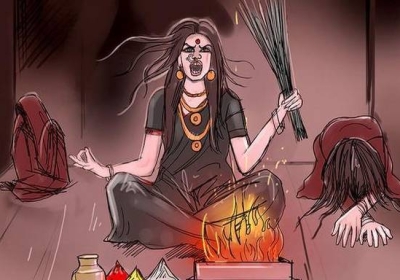Khasi Heritage: Folk Archery

The artistry is flourishing and the envy of other creatures culminates into enmity. The peaceful atmosphere in human society is thriving and there is hardly any disruption from the wild animals. Since the collapse of the giant tree, Diengïei, the tigers vowed to avenge human beings, and during the distribution of attributes the tiger overheard the commitment of the supreme divine to bestow physical strength on humans. On the day human beings are supposed to acquire physical strength, the tiger had already staked claim on behalf of humans. Humans were not aware that the tiger knew about it and had already betrayed, so when the supreme divine realised about the blunder, the Mother-decree sympathised with humans and promised to solve the problem. Mother-decree or Meihukum was worried about humankind and appeared before the pious couple Shinam and Mangring and bestowed upon them the art of making weapons for defense that could be utilised during merriment instead of fighting against anybody. Sormoh had already learnt the art of making musical instruments and used a particular species of bamboo called ‘Japung’ for making the pipe wind instrument known as Tangmuri, which is considered as the queen of musical instruments. The iron smelting is already functioning in the making of implements for domestic use and farming purposes and Mangring was instructed to make arrowheads and spears. Thereafter, Mangring followed the other instructions of Ka Meihukum to negotiate with the other materials for making the complete set of weaponry. Mangring used a variety of species of bamboo and cane, known as ‘Kdait’, ‘Shken’, ‘Rñai’, Riphin’ and ‘Stew’. The tiny bamboo sticks are used for fixing arrowheads, while the bigger cylinder is for the spears while the thick ones are for making the bows. According to the instructions of Ka Meihukum, neither the bottom part nor the top part of the bamboo should be used, because the middle portion is the ideal part for specific purposes, even though it was meant to protect and preserve the bamboo. After the arrowheads were fixed on the tiny bamboo sticks, the flight was not proper and Mangring was asked to negotiate with the kite to lend its feathers. Mangring went to the jungle and waited for the kite to shed the feathers and collected them for fixing fletching vanes on the other end of the arrow. The feathers on one end is the index fletch for the arrowhead at the other end to aim at the target. The feathers facilitate the precision of the flight of the arrow to strike the target. The bows were made from the middle portion of a thicker bamboo with three joints with both ends hooking the strings and the central joint for marking the arrowhead. Mangring was asked to handover the arrows and bows to his two sons, Batiton and Shynna, for playing.
While Batiton and Shynna were playing with bows and arrows using the wooden plate as the target, both of them could strike with their arrows and the fanfare attracted many onlookers. Among them is a mischievous person, Kajang who used to be jealous of the two brothers. Simultaneously, there was a dance festival in the nearby field and most of the spectators were diverted to the archery game played by the two children. Suddenly, there was an argument between the brothers perpetrated by Kajang about the number of arrows that stuck the target. Sometimes he supports the elder brother and ridicules the younger one, while within moments he changes his opinion and leads to the quarrel between the brothers. Ka Shinam was worried about the situation, because Ka Meihukum gifted the arts as a pastime for the archers and conflict was supposed to be encountered with the enemies. Their father found a solution and used different colours for marking near the fletching vane. The white colour is lime and the red colour is with sealing wax. After that, there was a specific marking of colour for both the archers and they knew their arrows. The mischievous person thought of another trick to obstruct the two brothers, and Kajang broke the wooden plate that they used as the target. When Mangring came to know about it, he urged upon Ka Meihukum to grant him a way for an amicable solution. Ka Meihukum asked Mangring to create a bunch made of stalks to be tied in three portions at the top, the middle and the bottom portion of the cylindrical bunch. Therefore, the Khasi form of archery target is a cylindrical bunch known as ‘Thong’ and the Khasi word ‘Thong’ also denotes the goal. Batiton and Shynna played joyfully and Kajang could not disrupt their fun and the dance festival was also enjoyed by everybody. That was the beginning of the traditional archery game and the two brothers, Batiton and Shynna, were the legends of archery in Khasi society.
Weapons also represent other aspects of human ingenuity that are essential for society. There are other significant purposes of archery in the Khasi milieu, which are connected with menfolk as warriors and protectors of the society. In the naming ceremony of a male child, a miniature bow and three arrows are the vital articles to be consecrated in favour of the infant. The three arrows signify protecting oneself, the family and the community or the nation. The archery articles are considered to strengthen the aura of the child and empower every man to be capable of safeguarding himself, his family members and the citizens of the nation. There are certain clans whose menfolk are muscular, courageous and a few huge physical stature, are categorised as the martial clan or ‘Khyndai-bah-ryntieh’ literally meaning the nine archers, while the giants are known as ‘Mar’ like the Marbañiang, Marthong, Marngar, Marpna and a few others are known as the martial clans. Apart from the clans with the prefix nomenclature of ‘Mar’ there are other clans that have produced famous giant warriors, like Mar Bilon Khyriem from the Khyriem clan, Mar Phalyngki from the Buam clan, who was known for the erection of a megalithic complex at Nartiang, Mon Bhut from the Wahlang Pahsyntiew clan, a fierce warrior and close confidante of Tirot Sing Syiem during the Anglo Khasi war of 1829 to 1833.
Khasi traditional archery transcends beyond the purpose of both pastimes and mechanisms of defense, but there are other aspects that relate to sporting spirit, community bonds, soulful destiny and spiritual verdict. The tradition of oath taking practice is done by licking salt from the blade of a sword and another method is to dip the arrow inside the gourd with accompanying prayers or covenant. During the cremation of a dead person, three arrows are shot in the north, south and west directions to protect the soul from the malevolent spirits and pave the way to the abode of the soul through the eastern direction. In any archery game, there is always a shaman who prays to the deities for a favourable bet to overpower the opponent and, usually, the shamans from both sides will argue and challenge each other with oral pledges believed to have been influenced and supported by the guardian spirits or the deities. It is always proclaimed that the skill of a versatile archer is futile without the reasoning power of the shaman and the encounter is expedited by the coordination among the archers, shaman and the deities. It is the essence of team work, motivating through divine intervention, wisdom of the shaman and technical skill of the archers.
La nam ka Meihukum, u Mangring bad ka Shinam;
La shei te ha ka skum, la ryntieh ki khnam shi kham.
La wien u Batiton, ba la siat te u Shynna;
Liang dieng te la kyllon, ba ka skum te ka la pra.
Pynieng la ka rasong, rongbiria ki sur phawar;
Ban jop te ha ka thong, dei ka nia na u nongswar.
Kynthei ki siat pharshi, tang shongshit paidbah byllien;
Shynrang ki kyoh mynthi, tamasa ha ki kyntien.







